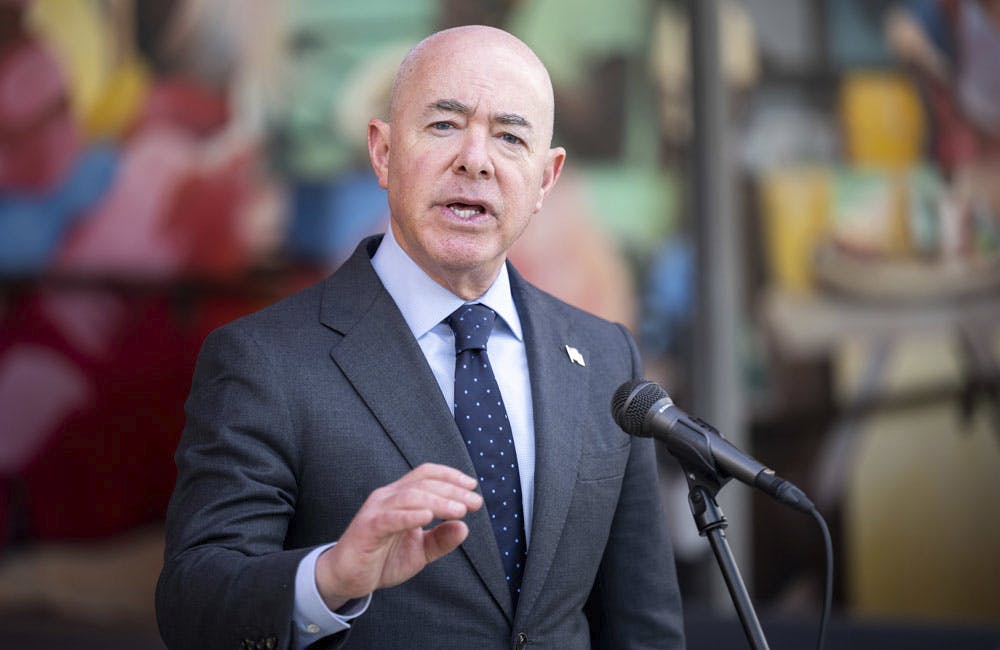DHS AI Roadmap Outlines Trustworthy Development Plan
DHS Secretary Alejandro Mayorkas sees the technology supporting criminal investigations, risk mitigation after disasters and training.

The Department of Homeland Security released its inaugural artificial intelligence roadmap outlining the technology’s potential across the agency’s enterprise. DHS Secretary Alejandro Mayorkas highlighted the ways the agency will be using generative AI in criminal investigations, training refugee and asylum officers and helping local communities develop mitigation plans after natural disasters.
“We’re seeking to demonstrate how AI can advance our mission, and not just incrementally, but significantly. And depending on the outcome of these pilots, it will shape and educate us about how we can employ AI in a number of our domains,” Mayorkas said during Axios’ What’s Next Summit Tuesday.
Mayorkas highlighted a pilot program using generative AI to enhance immigration officer training, saying that a real-life officer will ‘interview’ an AI machine that is trained to model someone seeking asylum at the border.
“We have trained the machine to simulate how an actual applicant responds to questions or reticence to disclose private information, difficulty in disclosing experiences that are traumatic,” Mayorkas said.
In addition to training, Mayorkas said AI is being used at the border in a non-intrusive way to find anomalies in commercial trucks and passenger vehicles. These anomalies indicate if people, chemicals or drugs are being smuggled.
“There is not a domain of the Department of Homeland Security, and the domain is quite vast and diverse, that we could not use AI,” Mayorkas said. “If, in fact, we learn how to use it responsibly, we understand what the implications are from a civil rights and liberties perspective, from a privacy perspective. The key to what we’re trying to do is to use it responsibly, understanding its risks.”
According to a release from DHS, the agency will launch two other project pilots: FEMA’s use of generative AI to create a more efficient hazard mitigation plan specifically for local governments and underserved communities, and Homeland Security Investigations will use large language models to enhance accuracy of summaries.
In February, DHS opened dozens of AI expert positions to leverage the use of AI across the agency. Mayorkas said that DHS has received more than 2,000 applications for the 50 available positions.
Mayorkas emphasized the use of technology as a way to advance the mission of DHS, and “will not replace the DHS employee,” but rather allow the agency to upskill its workforce.
“There are elements of our work that cannot be replaced by technology,” Mayorkas said. “When one is interviewing an individual for refugee status, one has to make credibility determinations … I would be reticent to turn that over to a machine.”
This is a carousel with manually rotating slides. Use Next and Previous buttons to navigate or jump to a slide with the slide dots
-

A Tech Perspective on Jimmy Carter’s Legacy
The late former president championed policies that set the stage for evolving innovations across tech, energy and digital equity.
4m read -

DOL's AI Chief Outlines Intersection of Tech and AI
DOL CAIO Mangala Kuppa is driving innovation, collaboration and ethical AI integration to enhance operational efficiency.
5m read -

Cyber Leaders Urge Congress to Modernize Election Security Systems
Experts prompt a bipartisan approach to cybersecurity to protect U.S. critical infrastructure and future elections from evolving threats.
4m read -

Defense Tech Developments to Watch in 2025
The new Fulcrum strategy sets up the Defense Department to shore up AI, zero trust and the workforce.
6m read








